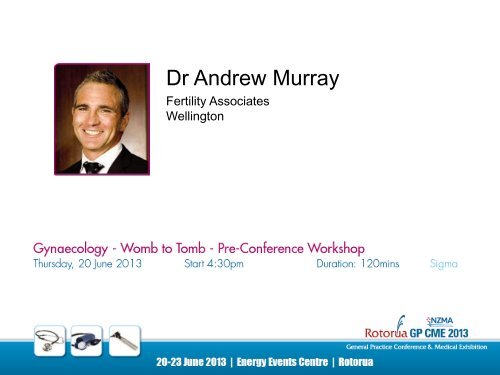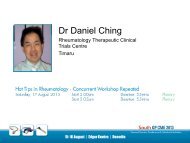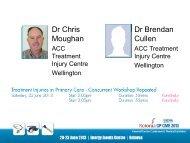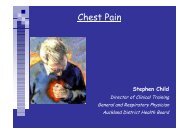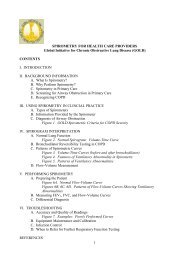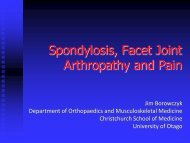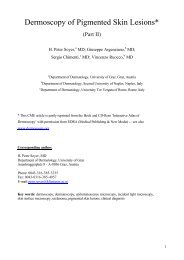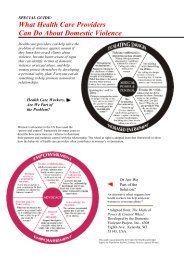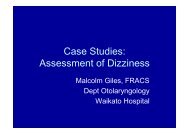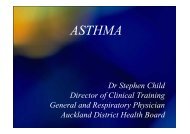Womb to Tomb
Womb to Tomb
Womb to Tomb
You also want an ePaper? Increase the reach of your titles
YUMPU automatically turns print PDFs into web optimized ePapers that Google loves.
Dr Andrew Murray<br />
Fertility Associates<br />
Welling<strong>to</strong>n
From <strong>Womb</strong> <strong>to</strong> <strong>Tomb</strong><br />
Women’s Health through their life stages<br />
Dr Andrew Murray
A bit about me….
Workshop Outline<br />
• Pre Conception Care<br />
• Adolescent Gynaecology<br />
• Menstrual Disorders<br />
• Menopause
Part 1<br />
PRE-CONCEPTION CARE
Case 1: Pre Conception Care
Case 1: Pre Conception Care<br />
• Jane is 27<br />
• Seeing you for routine smear<br />
• No past medical problems<br />
• Tom is 33 years old is a builder, enjoys a beer,<br />
occasional smoker in weekends<br />
• “Tom and I are thinking we might want kids<br />
one day, but we I’m not sure if I’m ready…. Is<br />
there anything I should be doing?”
This is really our patient
What are our Goals?<br />
• Maximize chances of conception<br />
• Minimize chances of abnormalities
Pre-Conception Care<br />
• Fetal Origins of Adult Disease<br />
• What core ingredients do we need <strong>to</strong> make a<br />
healthy baby?<br />
• What effects the quality of these ingredients?<br />
• Recommendations
3 Core Ingredients <strong>to</strong> make a baby<br />
3 Basic Ingredients <strong>to</strong> get pregnant
What Effects the Quality?
Eggs
Average Age of Mothers is Increasing
Average Age of Mothers is Increasing
Age has Effects on Egg Quantity
Age has Effects on Egg Quantity<br />
7 x10 6 1 x10 6 300K<br />
25K<br />
Birth Puberty Mid 30’s<br />
55
Age Effects Eggs Quality
The Biological Clock Waits for No-One
Don’t Leave it <strong>to</strong>o late
Sperm
Sperm are like DNA Delivery Vans<br />
…but what if the cargo is damaged
Men Have a Biological Clock Too
DNA damage increases with Age
Don’t Leave it <strong>to</strong>o late for men either!
What lifestyle fac<strong>to</strong>rs are important?<br />
• Age<br />
• Smoking<br />
• Weight<br />
• Diet and Exercise<br />
• Psychological stress<br />
• Caffeine consumption<br />
• Alcohol consumption<br />
• Exposure <strong>to</strong> environmental pollutants
Percentage of adults who smoke in NZ
Smoking and male fertility<br />
• In males smoking affects sperm production, motility,<br />
morphology and increases DNA damage<br />
• Child born <strong>to</strong> a father who smokes has 4 X risk of<br />
childhood cancer
Smoking and female fertility<br />
• Cotinine and cadmium detectable in follicular fluid<br />
• Menopause occurs 1 <strong>to</strong> 4 years earlier<br />
• Zona pellucida thicker
Copyright restrictions may apply.<br />
Homan, G.F. et al. Hum Reprod Update 2007 13:209-223; doi:10.1093/humupd/dml056
Implications of smoking in<br />
Fertility Treatment<br />
• 9 studies OR 0.66 (95%CI 0.49-0.88) for pregnancy per number<br />
of IVF cycles<br />
• Male smoking significantly reduced ICSI and IVF success rates<br />
• Female smoking doubles risk of early pregnancy loss
Relative risk of infertility vs BMI<br />
Relative risk<br />
4.0<br />
3.5<br />
Public funding<br />
cut off<br />
3.0<br />
2.5<br />
2.0<br />
1.5<br />
1.0<br />
0.5<br />
0.0<br />
32<br />
BMI
Weight…<br />
Overweight men<br />
Body Mass Index<br />
(BMI > 28)<br />
have sperm counts<br />
22% lower<br />
41
Lifestyle modification programmes<br />
• 87 obese women (BMI>30)<br />
• Weekly programme exercise and diet for 6 months<br />
• Average weight loss 10kg<br />
• 80% women were anovular, 90% ovulating at 6<br />
months<br />
• 78% pregnant 68% live birth
Stress<br />
May reduce female reproductive<br />
performance through effects on<br />
au<strong>to</strong>nomic, endocrine and immune<br />
systems
Effects of counselling and support on ART pregnancy rates<br />
Homan, G.F. et al. Hum Reprod Update 2007 13:209-223; doi:10.1093/humupd/dml056
Caffeine…<br />
Caffeine may impact on treatment<br />
• 221 women (Cohen et al, 2002)<br />
• Caffeine 2-50mg/day compared with nil<br />
OR 3.1(95%CI 1.0-9.7) for no livebirth<br />
• Caffeine>50mg/day<br />
OR 3.9 (95%CI 1.3-11.6)<br />
• Starbucks grande latte 150mg caffeine<br />
46
Alcohol is not good for fertility, or baby<br />
• Known tera<strong>to</strong>gen<br />
(affects embryo/fetus development)<br />
• Reduces female fertility<br />
• Increases miscarriage risk<br />
• Unknown safe level during pregnancy<br />
• Men >20 standard drinks per week reduced numbers of pregnancies
What about Folic Acid?<br />
• What dose?<br />
• Folic acid alone or Multi vitamins?<br />
• How long for?
What about Folic Acid?<br />
• What dose?<br />
– If his<strong>to</strong>ry of Neural Tube defect in first degree relative 5mg daily<br />
– Otherwise 0.5 <strong>to</strong> 0.8mg daily<br />
• Folic acid alone or Multi vitamins?<br />
– Multivitamins with 0.4-0.8 folic acid showed a 92% reduction in NTD<br />
– Only the Multivitamin preparation showed an additional reduction in<br />
other defects eg. Urinary tract, limb deficiencies, pyloric stenosis<br />
(Cziezel 2004)<br />
• How long for?<br />
– 3 Months pre-conception and 1 st Trimester
Take Home Messages<br />
• Maintain a healthy weight
Take Home Messages<br />
• Maintain a healthy weight<br />
• Don’t smoke
Take Home Messages<br />
• Maintain a healthy weight<br />
• Don’t smoke<br />
• Reduce caffeine
Take Home Messages<br />
• Maintain a healthy weight<br />
• Don’t smoke<br />
• Reduce caffeine<br />
• Reduce or avoid alcohol
Take Home Messages<br />
• Maintain a healthy weight<br />
• Don’t smoke<br />
• Reduce caffeine<br />
• Reduce or avoid alcohol<br />
• Folic Acid
Take Home Messages<br />
• Maintain a healthy weight<br />
• Don’t smoke<br />
• Reduce caffeine<br />
• Reduce or avoid alcohol<br />
• Folic Acid<br />
• Consider Sperm health
Take Home Messages<br />
• Maintain a healthy weight<br />
• Don’t smoke<br />
• Reduce caffeine<br />
• Reduce or avoid alcohol<br />
• Folic Acid<br />
• Consider Sperm health<br />
• Don’t leave it <strong>to</strong>o late
Part 2<br />
ADOLESCENT GYNAECOLOGY
Case 2: Painful Periods
Case 2: Painful Periods<br />
• Jade is 17<br />
• Menarche at age 13<br />
• Periods have always been painful<br />
• Has had heaps of time off school – is affecting<br />
her grades<br />
• Wants <strong>to</strong> start nursing next year
What are our Goals?<br />
• Treat symp<strong>to</strong>ms effectively<br />
• Maximize quality of life<br />
• Ultimately make a diagnosis if possible
Painful Periods<br />
• Primary Dysmenorrhoea<br />
• Secondary Dysmenorrhoea<br />
– Endometriosis<br />
– Adenomyosis<br />
– Pelvic inflamma<strong>to</strong>ry disease<br />
– Adhesions<br />
– Outflow Obstruction<br />
– Ovarian cysts<br />
– Inflamma<strong>to</strong>ry bowel disease
Primary Dysmenorrhoea<br />
• Prevalence as high as 90%<br />
• Under reported<br />
• Rates of absenteeism range from 34 <strong>to</strong> 50<br />
percent<br />
• US Study 600 million lost work hours and $2<br />
billion in lost productivity annually<br />
Andersch B, Milsom I. An epidemiologic study of young women with dysmenorrhea.<br />
Am J Obstet Gynecol. 1982;144:655–60.<br />
Sundell G, Milson I, Andersch B. Fac<strong>to</strong>rs influencing the prevalence and severity of<br />
dysmenorrhea in young women. Br J Obstet Gynaecol. 1990;97:588–94.
Primary Dysmenorrhoea: Risk Fac<strong>to</strong>rs<br />
• earlier age at menarche<br />
• long menstrual periods<br />
• smoking<br />
• obesity<br />
• alcohol consumption<br />
Harlow SD, Park M. A longitudinal study of risk fac<strong>to</strong>rs for the occurrence,<br />
duration and severity of menstrual cramps in a cohort of college women. Br J<br />
Obstet Gynaecol. 1996;103:1134–42
The pathology dictates the treatment<br />
Chan WY, Dawood MY: Prostaglandin levels in menstrual fluid of<br />
nondysmenorrheic and dysmenorrheic subjects with and without oral<br />
contraceptive or ibuprofen therapy. Adv Prostaglandin Thromboxane<br />
Leukotriene Res 8:1443, 1980<br />
• PGF2α released as menstruation begins<br />
• PGF2α stimulates myometrial contractions<br />
ischemia and sensitization of nerve endings
Treatment<br />
• NSAIDs<br />
• 73 RCTs in Cochrane review 2010<br />
Nonsteroidal anti-inflamma<strong>to</strong>ry drugs for dysmenorrhoea<br />
Jane Marjoribanks et al.<br />
• NSAIDs were significantly more effective for pain relief<br />
than placebo (OR 4.50, 95% CI: 3.85, 5.27).<br />
• NSAIDs were also significantly more effective for pain<br />
relief than paracetamol (OR 1.90, 95% CI:1.05 <strong>to</strong> 3.44).<br />
• When NSAIDs were compared with each other there<br />
was little evidence of the superiority of any individual<br />
NSAID for either pain-relief or safety
Take Home Messages<br />
Primary Dysmenorrhoea<br />
• NSAID are very effective BUT<br />
• Women need <strong>to</strong> use them effectively<br />
• Combined OCP also very effective<br />
• NSAID/OCP in conjunction will help
What helps distinguish<br />
Primary from Secondary<br />
Dysmenorrhoea?<br />
• Dysmenorrhea during the first one or two cycles (congenital<br />
outflow obstruction?)<br />
• Dysmenorrhea beginning after 25 years of age<br />
• Pelvic abnormality on physical examination<br />
• Coexisting infertility<br />
– endometriosis, pelvic inflamma<strong>to</strong>ry disease or other causes of<br />
scarring<br />
• Heavy menstrual flow or irregular cycles<br />
– adenomyosis, fibroids, polyps<br />
• Dyspareunia<br />
• Little or no response <strong>to</strong> NSAIDs or OCP
How is it Endometriosis<br />
best diagnosed?<br />
• His<strong>to</strong>ry
How is it best diagnosed?<br />
• His<strong>to</strong>ry<br />
• Ultrasound
How is it best diagnosed?<br />
• His<strong>to</strong>ry<br />
• Ultrasound<br />
• MRI?
How is it best diagnosed?<br />
• His<strong>to</strong>ry<br />
• Ultrasound<br />
• MRI?<br />
• Laparoscopy
Take Home Points<br />
• Dysmenorrhoea is under-estimated<br />
• Huge Social Cost<br />
• Don’t Assume Patient is treating symp<strong>to</strong>ms<br />
with OTC meds<br />
• NSAIDs and OCP good first line (90% efficacy)<br />
• Lack of response ? Endo<br />
– Arrange scan and refer
Case 3: Absent Periods
Case 3: Absent Periods<br />
• Jacinta 16<br />
• No period yet<br />
• Keen runner (>50km/week)<br />
“My girlfriends have all had there period for<br />
years, I’m not bothered, but Mum said I have<br />
<strong>to</strong> get this checked out”
Primary Amenorrhea<br />
Definition<br />
• Failure of menses <strong>to</strong> occur by age 16 years.<br />
• Failure of menses <strong>to</strong> occur within 5 years of<br />
first secondary sexual characteristics.
Normal Sequence of Development<br />
• breast budding<br />
• development of pubic hair<br />
• accelerated growth<br />
• finally menarche
Question <strong>to</strong> Ask?<br />
• Is there otherwise normal sexual<br />
development?<br />
• If No, constitutional/idiopathic is most likely<br />
diagnosis<br />
• If Yes, next thing <strong>to</strong> establish – Is there a<br />
Uterus?
Basic Investigations<br />
• Karyotype<br />
• FSH<br />
• Abdomino-pelvic ultrasound.
Evaluation of Primary Ammenorrhoea<br />
His<strong>to</strong>ry and Physical Examination<br />
No<br />
Measure FSH and LH<br />
Secondary sexual characteristics present?<br />
Yes<br />
Ultrasound of Uterus<br />
FSH and<br />
LH 20<br />
Absent or abnormal<br />
Present and normal<br />
Hypogonadotrophic<br />
hypogonadism<br />
Hypergonadotrophic<br />
hypogonadism<br />
Karyotype<br />
Outflow<br />
Obstruction?<br />
Karyotype<br />
46 XY<br />
Androgen<br />
insensitivity<br />
46XX<br />
Mullerian<br />
Agenesis<br />
No<br />
Yes<br />
46 XX<br />
Premature Ovarian Failure<br />
46XO<br />
Turners Syndrome<br />
Evaluate for<br />
Other causes<br />
Imperforate hymen<br />
or transverse septum
Important <strong>to</strong> rule out<br />
Pregnancy<br />
Thyroid Disease<br />
Prolactinoma<br />
Referral
Treatment<br />
• Treat Underlying cause<br />
• Prevention of osteoporosis,<br />
• Progression of normal pubertal development
In our case?<br />
• Wasn’t pregnant<br />
• Normal TSH, Prol, Karyotype<br />
• Had uterus on scan<br />
• BMI 17<br />
• Counseled <strong>to</strong> reduce exercise intensity<br />
• Dietician re Increasing BMI<br />
• OCP <strong>to</strong> induce bleeds, protect bones until BMI<br />
healthier
Part 3<br />
MENSTRUAL DISORDERS
Case 4: Irregular Periods<br />
• Judy is 32<br />
• She s<strong>to</strong>pped the pill bout 9 months ago<br />
• Only 2 periods since<br />
• Skin is now “terrible”<br />
• Last period was really heavy<br />
“What is wrong with me? My cycle is<br />
everywhere and I’d like <strong>to</strong> have better<br />
skin again … its really getting me down.”
What are our Goals?<br />
• Make the right diagnosis<br />
• Target therapy <strong>to</strong> the symp<strong>to</strong>ms<br />
• Manage long term health implications
Polycystic Ovary Syndrome<br />
2 out of the following 3 features:<br />
• Irregular or Absent periods<br />
• Clinical (acne or hirsutism)<br />
Biochemical (raised LH or T)<br />
evidence of raised androgens<br />
• Polycystic Ovaries on Scan<br />
Exclude other causes……. Check Prolactin and TSH
POLYCYSTIC OVARIES
Prevalence<br />
• Polycystic Ovaries (PCO)<br />
– increased ovarian stroma<br />
– 12+ follicles 2-9mm<br />
– increased ovarian volume (>10ml)<br />
• Polycystic Ovarian Syndrome (PCOS)<br />
above + signs of excess androgens<br />
– oligomenorrhoea<br />
– obesity<br />
– acne and hirsutism
Clinical Presentation<br />
• Menstrual Dysfunction<br />
– periods often
Genetics and PCOS<br />
• >70 genes identified<br />
• Gonadotrophins<br />
• Androgens<br />
• Insulin Signalling<br />
• Obesity
PCO and Insulin Resistance<br />
• Hyperinsulinaemia and insulin resistance.<br />
• 20-40% PCO women go on <strong>to</strong> develop NIDDM<br />
(especially obese).<br />
• In PCO there is probably a post-recep<strong>to</strong>r<br />
defect.
PCO and Insulin Resistance<br />
Insulin Recep<strong>to</strong>r<br />
Insulin<br />
Glucose<br />
Tyrosine<br />
PO 4 -<br />
Serine<br />
PO 4 -<br />
Glucose<br />
transporter<br />
protein<br />
Blockade ?<br />
Downstream events<br />
EVENTS<br />
Fig. 1: Possible intracellular events after activation of the insulin recep<strong>to</strong>r by insulin binding in<br />
women with polycystic ovary syndrome
PCO and Long term disease risks<br />
Table 1. Long term Disease Risks in Polycystic Ovary Syndrome (independent of obesity)<br />
Increased risk definite or very likely<br />
Type 2 Diabetes Mellitus<br />
Dyslipidaemia<br />
Endometrial Cancer<br />
Increased risk possible<br />
Hypertension<br />
Cardiovascular disease<br />
Gestational diabetes mellitus<br />
Pregnancy-induced hypertension<br />
Ovarian Cancer<br />
Increased risk unlikely<br />
Breast cancer<br />
from Solomon CG: The epidemiology of polycystic ovary syndrome. Prevalence and associated disease risks. Endocrin Metab Clin N<br />
America 28(2):247-263, 1999
Treat the Presenting Symp<strong>to</strong>m<br />
• Cycle Control<br />
– OCP<br />
• Increases SHBG (reduces free T)<br />
• Protects against Endometrial Hyperplasia<br />
• Cypreterone containing OCP eg Diane, Estelle<br />
• Hirsutism<br />
– OCP<br />
– Spirinolac<strong>to</strong>ne<br />
• Metabolic Protection<br />
– Understanding CHO Metabolism –> low carbs<br />
– Metformin<br />
– Exercise<br />
• Fertility<br />
– Weight control<br />
– Clomiphene<br />
– Advanced Treatment (gonadotrophins, ovarian diathermy, IVF)
Case 5: Heavy Periods<br />
• Anna is 44<br />
• 3 children (14, 11 and 7)<br />
• Last 24 months increasingly<br />
heavy periods<br />
• Knows where every loo in the<br />
shopping mall is<br />
• Has had a couple of “accidents”<br />
with bleeding<br />
• Is very tired all the time<br />
“I’m fed up with this … its doing my<br />
head in!”
What are our Goals?<br />
• Make the right diagnosis<br />
• Improve quality of life<br />
• Have a definitive plan in place
HMB: Differential Diagnosis<br />
• Fibroids<br />
• PCOS<br />
• Polyps<br />
• Endometriosis<br />
• Endometrial Hyperplasia<br />
• Dysfunctional uterine bleeding
HMB: Standard Work Up<br />
• His<strong>to</strong>ry and Exam<br />
• FBC, Iron Studies, TSH<br />
• Ultrasound
HMB Treatment Options:<br />
Medical<br />
NSAIDs<br />
OCP<br />
Anti-fibrinolytics<br />
Mirena<br />
Surgical<br />
Ablation<br />
Hysterec<strong>to</strong>my
• NSAIDs<br />
• OCP<br />
• Danazol<br />
• Tranexamic Acid<br />
Treatment Options:<br />
Medical and Reversible<br />
reduce PGs<br />
most women are<br />
“over the OCP”<br />
bad side effects<br />
the most effective<br />
oral therapy<br />
• Mirena very effective 90%<br />
experience less or no<br />
bleeding<br />
» Hb
Treatment Options:<br />
Surgical and Irreversible
Hysterec<strong>to</strong>my<br />
• Abdominal<br />
• Vaginal<br />
• Laparoscopic<br />
• “I wish I had done<br />
this years ago..”
Part 4<br />
MENOPAUSE
Case 6: Menopause<br />
• Martha is 52<br />
• Last period was 12 months ago<br />
• Distressing hot flushes (soaks bed at night)<br />
• Not interested in sex, it has become uncomfortable<br />
“I’m just not myself, I don’t seem <strong>to</strong> be able <strong>to</strong> think<br />
straight!”
What are our Goals?<br />
• Alleviate Symp<strong>to</strong>ms<br />
• Improve quality of life<br />
• Minimize/Counsel regarding Risks/Benefits
HRT<br />
• Who Can<br />
• Who Cant<br />
• Pros<br />
• Cons<br />
• How Long<br />
• Other Options
HRT: Who?<br />
• Women with symp<strong>to</strong>ms interfering quality of<br />
life<br />
• Exclude other possible causes:<br />
– Thyroid<br />
– Depression<br />
– Diabetes<br />
– Iron deficiency<br />
– Drug effects
Review after 6 months then annually<br />
Are needs being met?<br />
Any new contraindications?<br />
HRT<br />
urogenital symp<strong>to</strong>ms alone<br />
hysterec<strong>to</strong>my<br />
vaginal oestrogen<br />
continuous oestrogen<br />
Intact Uterus<br />
Premature<br />
Menopause<br />
1 year<br />
ago<br />
Or<br />
Continuous Oestrogen<br />
+<br />
Cyclic Progestin<br />
Or<br />
LNG IUD
Non HRT Options for Hot Flushes<br />
• Venlafaxine<br />
• Paroxetine<br />
• Clonidine<br />
• Gabapentin
HRT Contraindicated<br />
• his<strong>to</strong>ry of breast cancer<br />
• endometrial cancer<br />
• unexplained vaginal bleeding<br />
• his<strong>to</strong>ry of DVT<br />
• his<strong>to</strong>ry of, or increased risk of, heart disease or<br />
stroke
Possibly Contraindicated<br />
• liver disease<br />
• migraines<br />
• epilepsy<br />
• diabetes<br />
• gall bladder disease<br />
• fibroids<br />
• endometriosis<br />
• hypertension<br />
Consider Route of Administartion<br />
Weigh Up Risks vs Benefits
HRT Benefits<br />
Treatment of menopause symp<strong>to</strong>ms<br />
• hot flushes and vaginal dryness<br />
• lowered mood<br />
• anxiety<br />
• insomnia<br />
• headaches,<br />
• muscle and joint pain<br />
• decreased sex drive
HRT Benefits<br />
Osteoporosis<br />
• Prevention of bone loss.<br />
• Decreases fractures of the verterbrae by up <strong>to</strong> 40 per cent<br />
• Reduces hip fractures<br />
Heart disease<br />
• Original studies indicated that oestrogen replacement therapy may<br />
protect post-menopausal women against coronary heart disease.<br />
• Confirmed in women 60 and especially<br />
over 70 years of age<br />
• Standard oral therapy should be avoided in women who already have<br />
established coronary heart disease.
HRT Benefits<br />
Short-term memory and Alzheimer's disease<br />
May prevent or delay the onset of Alzheimer's disease.<br />
Colorectal cancer<br />
HRT reduces the risk of colorectal cancer.
HRT Risks<br />
Breast cancer<br />
• Long-term HRT (oestrogen with progestin) is associated with a slight<br />
increase in the risk of developing breast cancer. (WHI) (July 2002<br />
• For women who have had a hysterec<strong>to</strong>my and take oestrogen only the<br />
WHI study of 11,000 women has shown no increase (rather a trend <strong>to</strong><br />
decrease) in breast cancer risk.<br />
Thrombosis<br />
• There is an increased risk of venous thrombosis in women using HRT,<br />
however the incidence is very low and more likely in the first year of<br />
therapy.
Take Home Messages<br />
• Short Term (
From <strong>Womb</strong> <strong>to</strong> <strong>Tomb</strong>:<br />
• Care of women starts before they are born<br />
• We need <strong>to</strong> do better at diagnosing and<br />
treating pelvic pain<br />
• PCO has immediate and long term issues<br />
• HMB has logical treatment options<br />
• HRT is not the bad guy – can make a huge<br />
difference <strong>to</strong> quality of life


